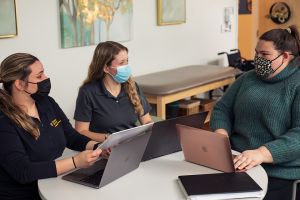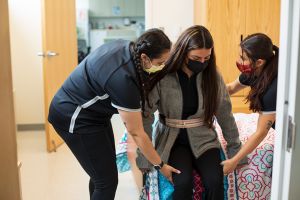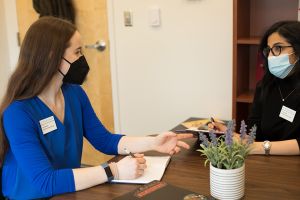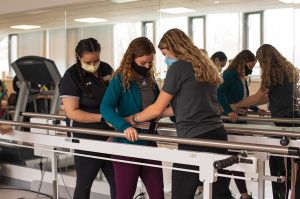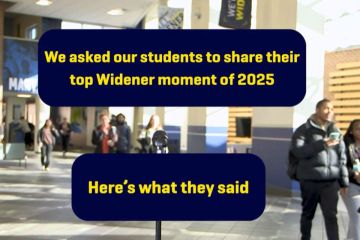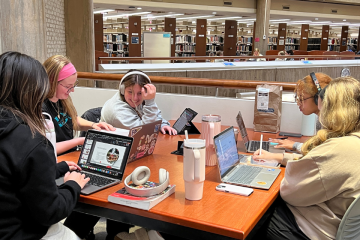The Future of Widener’s Health Science Programs Is Bright, and Integrated

Interprofessional learning isn’t a new concept in higher education. The approach is an established best practice as a means to introduce students to peers in related programs and encourage cross-disciplinary collaboration, especially among cohorts who can expect to have similar interactions in their careers.
Interprofessional learning at Widener, however, is taking the tried and true practice to a new level with the expansion of health science programs in the College of Health & Human Services (CHHS) and School of Nursing as well as investments in academic & learning spaces.
Since 2019, CHHS has launched the occupational therapy doctoral (OTD) and speech-language pathology (SLP) master’s programs to its roster of powerhouse programs, which includes the nationally recognized doctor of physical therapy (DPT) program.
As the number of health programs continues to grow, so too does the robust student experience.
“We have a great learning formula here for tremendous learning experiences, and I’m convinced that we’re going to be graduating health care professionals who are ready to engage with each other as they seek to engage with the community and their clients,” said Jill Black, associate dean of CHHS and director of the Institute for Physical Therapy Education.
Additions to Widener’s programming, which will continue with the arrival of the physician assistant studies (PA) program in CHHS by fall 2022 and nutrition science in the School of Nursing by fall 2023, reflect Widener’s strategic vision to elevate its health and human service programs.
“We are poised to do some really exciting things because we’re building this from the ground up,” said Black.
Read about renovations underway to support the health science programs
Interprofessional from the Start
Research shows that an interprofessional approach creates a richer academic experience, enabling students to build proficiency and develop a deep understanding of their roles in relation to their counterpart health care providers.
At Widener, interprofessional learning and engagement are built into students’ academic careers at multiple levels, both academically and clinically, starting from day one.
“It’s very unique to Widener to have students together in didactic coursework as well as clinical experiences,” said Kathleen Youse, associate professor and founding director of the Institute for Speech-Language Pathology. “You don’t really see that at other universities.”
Core courses, like anatomy, merge students in the DPT, OTD, and SLP – and eventually PA – programs together in the classroom in the first semester, a move that Youse says sets the tone for a collaborative environment.
“That interdisciplinary collaboration is infused throughout the course. It’s not just that they’re in the classroom together, they’re actually having that opportunity to work with one another throughout the course,” said Youse.
As with the Chester Community Clinic, infusing interprofessional practices at the academic level directly informs care provided in the Speech-Language Pathology Clinic, the university’s latest student-led pro bono clinic located in Melrose Hall, which was recently renamed the Julie E. Wollman Hall.
Grand rounds exercises, in which students work in interprofessional teams to evaluate client cases, position students to develop comprehensive treatment plans and work in clinically diverse care teams, just as they can expect to do as soon-to-be licensed professionals.
“We’re able to grow the care in the clinic to be truly interprofessional and not just siloed services, allowing students to see the client as the center of care and each of them as participants in that care,” said Black, who also noted opportunities for clinical collaboration with the upcoming nutrition science program as well.
A Collaborative Network of Learning
Interprofessional collaborations stretch across campus. An integrated activity between OTD and clinical psychology, for instance, brings students together to practice administering interview-based assessments, a core competency required in both professions.
“Programming continues to evolve to make for a better experience for the students and give them more of the inside track that we’re trying to provide to them,” said Wendy Wachter-Schutz, associate professor and founding director of the Institute for Occupational Therapy.
These strategic partnerships, according to Bridget Trivinia, clinical associate professor and director of OTD fieldwork education, is a testament to how Widener’s health science programs have grown in tandem with one another.
“As the OTD program has established deeper roots, one of our objectives is for students to have opportunities with other disciplines whether it be through an interprofessional course or an interprofessional learning assignment,” said Trivinia.
Similarly, program leaders in SLP and clinical psychology are partnering to develop an upcoming counseling course. Youse explains that it’s these kinds of non-clinical experiences that round out the curriculum and build a foundation for students to work alongside professionals that they may encounter in a future job setting.
It also opens the door for future partnerships with social work, education, and human sexuality as well.
“There’s a lot of opportunity for collaboration across all of the programs within the College of Health and Human Services,” said Youse.
Building A Community of Leaders
From the Child Development Center to schools and health centers in Delaware County, Widener’s health science students are honing their skills as leaders through community-based programming.
As with the academic experience, there is a concerted effort to create interprofessional student leadership opportunities in all organizations that students interface with such as the community health clinics, national honor societies, and professional groups.
In spring 2022, student leaders in the Chester Community Clinic hosted the Pro Bono Network Conference. The annual conference, which returned in-person after going virtual due to COVID-19, welcomed students from colleges and universities who also offer pro bono rehabilitation health care services to build connections and share research.
For the first time in Widener’s history of hosting the event, students from all three disciplines—DPT, OTD, and SLP—held conference leadership positions, which entailed everything from organizing the event to coordinating key speakers and approving research proposals.
“Through a leadership position, students get to learn their own roles and they get to work with a counterpart in physical therapy and now in speech-language,” said Wachter-Schutz.
According to Lori Felker, founding director of the Institute for Physician Assistant Education, students who will enroll in the newest health science major will join this culture of interprofessional and community-minded learning opportunities.
“Students can expect a very primary care based and very community-health centric program,” said Felker. “Part of our goal and vision for the program is to be very community-health minded.”
Widener’s unique and deliberate emphasis on local engagement and awareness shapes students to become culturally competent clinicians equipped to serve diverse populations in a wide range of settings.
In the Speech-Language Pathology Clinic, for example, graduate clinicians provide services in the clinic’s bilingual program; therapy for bilingual clients is a skill held by only 8 percent of speech-language therapists.
“There are not a lot of programs in the country that focus on bilingual training in speech-language pathology, so we’re hoping to not only contribute to the students’ education but also to the field by offering those experiences,” Youse explained.
SLP students are putting that training into action in fieldwork placements at Drexel Neumann Academy where they work alongside teachers and therapists to provide supplemental speech services to English-speaking students, as well as young English Language Learners.
With each engagement, Black explains, students learn how to be proactive advocates for their clients and communities, not just by providing health care services, but also by liaising policy changes, resources, and education wherever applicable.
“We want to be community-minded and community-focused and be thinking about the overall health and well-being of the community,” Black said.

